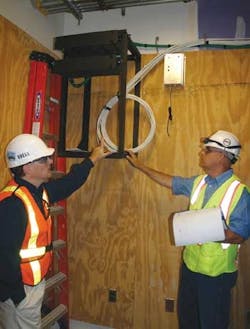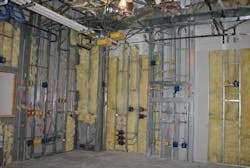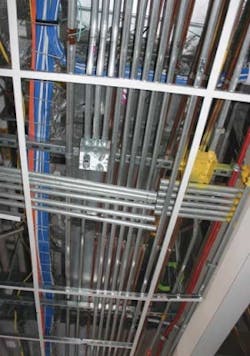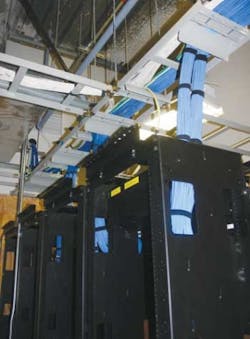Building an IP-based hospital megaplex
The new 1.6-million square-foot Johns Hopkins hospital opening in 2012 will be a showplace for IP connectivity.
By Carol Everett Oliver, RCDD/ESS, Berk-Tek, a Nexans company
There is one basic reason why Johns Hopkins is the nation's highest-ranking hospital in the U.S. News & World Report for the 20th consecutive year: their commitment to continually setting high standards of healthcare through continuous investment in technology for ongoing medical research and education. To accomplish their aggressive goals, nonprofit Johns Hopkins Medicine, which comprises the hospital and health services, incorporates the best tools available for modern healthcare. In addition, neighboring Johns Hopkins University is top among U.S. universities to receive federal research and contributed development funds. A culmination of all of these assets will be realized when the new Johns Hopkins Hospital opens its doors in 2012.
This new 1.6 million-square-foot hospital, located in Baltimore, MD, will raise the bar for healthcare services, and give its own meaning to "healthcare reform." The new hospital, with a budget exceeding $900 million mainly from donations, will replace the adjacent 50-year old hospital, and will consist of two connected 12-story towers, one focusing on cardiovascular and critical care and the other on pediatric care and women's health.
"Although the existing buildings have served their purposes well, they are no longer adequate to accommodate today's patients and current medical technologies," stated Ronald R. Peterson, president of The Johns Hopkins Hospital and Health System and the executive vice president of Johns Hopkins Medicine. The current hospital had been built in the 1960s and has had its fair share of retrofitting, which included bringing new services in through solid plaster and marble walls. "To maintain our number-one status, we realized that a redevelopment plan became vital, not only because of the growing need for additional research and clinical space, but because of the inadequacy of existing spaces, designed for an earlier era of medicine when infrastructure, equipment and delivery of care were much less complex," states Matthew Odell, project manager for the information technology (IT) department, who has been working at Johns Hopkins for 16 years. "We wanted to build a hospital that would have all of the newest technologies and incorporate everything IP," he adds.
An aerial shot of the construction of the 1.6 million-square-foot Johns Hopkins Hospital, located in the heart of Baltimore which consists of two connected 12-story towers; one focusing on cardiovascular and critical care and the other for pediatric care and women's health.
Not surprising, healthcare services have become one of the fastest adopters of the latest Internet Protocol (IP) communications technology. New government regulations through the Office of the National Coordinator for Health Information Technology (ONC), such as the Health Information Technology for Economic and Clinical Health (HITECH) Act, enacted as part of the American Recovery and Reinvestment Act (ARRA) of 2009 are promoting the adoption of interoperable electronic health records (EHRs) and subsequently developing a national health information network to securely exchange data and make all records electronic by 2014.
Gaining recent recognition in the telecommunications industry is the newly published ANSI/TIA-1179 Healthcare Facility Telecommunications Infrastructure Standard, which addresses cabling methods to support a broader scope of application-specific systems requiring a range of work area densities. In addition to data records, the integration of other low-voltage systems, such as nurse call, physio monitoring, radio frequency identification (RFID), equipment sensors and access control, to name a few, are sharing the same pipe as communications cables and are being attached to the same or parallel networks.
The A/V equipment cables and termination components are located in a separate Legrand/Ortronics wall-mount cabinet in the EIDFs. Pictured are Matthew Odell, project manager for the Johns Hopkins IT department (left), and Stephen Eckels, RCDD, TPM, operations supervisor for Vision Technologies (right).
Johns Hopkins' IT department was already deep in the network planning stages for the new hospital before the ratification of the standard. The internal IT team, along with outside trades such as architects, network designers and consultants, were faced with selecting a structured cabling solution to support today's applications, along with preparing the network for other forecasted IP systems. In doing so, their design efforts coincidentally mirrored many issues addressed by the standard.
Making the rounds
The new complex will consist of 560 patient beds, all in private rooms-355 for adults and 205 for children. Other areas include 33 operating rooms, pediatric acute-care rooms, trauma service, modernized digital diagnostic imaging and radiology facilities, and an indoor play area. Planning one of the largest hospital construction projects to date includes massive coordination of the design and implementation-almost two years prior to the first shovel in the ground.
"The hardest part of the entire infrastructure design was first identifying network bandwidth and speed requirements since technology constantly changes," states Odell. "When we first looked at the needs of the backbone, we were running one Gigabit. The pipe grew and we decided upon a 40-Gigabit core, which would give 10 Gigabits to every access layer closet," he notes. Because there are diverse redundant runs from the main distribution frame (MDF), this actually provides 20 Gigabits to every telecommunication room, which they designate as intermediate distribution frames (IDFs).
Within the 12 stories, the first seven floors are joined, but from floors 8 through 12, the floors branch out to two separate towers. Because of this unique layout, each floor is divided into quadrants, "A, B, C and D" and one IDF is located in each quadrant. The IDF is a secure, locked room that is attached to the EIDF (external IDF). The IDF includes all of the hospital-owned data plant, voice and other low-voltage cabling and building automation system (BAS) termination equipment. Only approved internal IT personnel can access the IDF by first passing through the EIDF. The EIDF houses all of the active equipment and connections provided by outside vendors, such as cable TV, A/V, phone services, CCTV, distributed antenna system (DAS), emergency equipment as well as other internal departments, such as engineering, which are kept separate from the main network.
To provide network service to the 30,000 users on campus, as well as connect to the outside world, there are two diverse and redundant outside plant paths encompassing 192 strands each of Berk-Tek (www.berktek.com) singlemode fiber. In addition, there is a dedicated 48-strand singlemode cable for cell coverage within the new building, which allows the fire department and emergency system notification radios to work everywhere. This cable runs from the DAS headend, located on the campus, into the new hospital building's EIDF rooms.
The newly ratified ANSI/TIA-1179 standard classifies densities of low, medium or high ranges for workstation outlets in hospital areas. An operating room (OR) is listed as "high," which includes a minimum of 14 outlets. Pictured here is one of the new ORs with upwards of 38 outlets located on the walls and also overhead on booms.
Johns Hopkins also generates its own power to assure 100 percent uptime. Johns Hopkins owns and operates two power plants to provide main and backup power from two different locations for all 50 buildings. A new power plant was recently built to assure service to the new hospital.
"For the communications infrastructure, we looked for a warranted system that could guarantee years of network reliability and scalability," states Odell. "Together, Berk-Tek, a Nexans Company, and Legrand/Ortronics (www.ortronics.com) offer NetClear cabling solutions, which are total end-to-end cabling systems with a 25-year warranty. We specified a fiber system, NetClear MM10, mainly for the backbone and for other direct services, and the NetClear GT2 Category 6 copper solution for the horizontal," explains Antonio Prezioso, with Network Products Inc., the manufacturers' representative for Berk-Tek and Legrand. All of the cables in the IDF and EIDF are terminated and crossconnected to the active equipment mounted in the Legrand/Ortronics Mighty Mo 6 Cable Management Racks, except for the A/V equipment, which is in a separate Legrand/Ortronics wall mount cabinet in the EIDF.
Pictured here are some of the key network and cabling installation team (left to right): Matthew Odell, project manager for the Johns Hopkins IT department, with Vision Technologies' Dennis Hook, senior project manager; Alfredo Rivero, TPM, project foreman; Jake Hughes, lead technician; Stephen Eckels, RCDD, TPM, operations supervisor; and Jamie Martinez, lead technician.
The general riser backbone cable from the MDF to the IDFs is Berk-Tek's premise distribution cable, 24-strand of both multimode and singlemode. Each EIDF has an additional 12 strands of Berk-Tek's standard interconnect fiber-optic multimode cable for use by the clinical engineering department. There is also additional riser cable-48 strands of singlemode and 24 strands of multimode cable–that connects directly to the intensive care operating rooms (located on the 3rd, 4th and 5th floors).
Additional dedicated and redundant fiber cables service critical areas including the operating rooms, epilepsy monitoring unit (EMU) and all of the elevator cabs. In an operating room, there are two Berk-Tek six-stranded fiber-optic cables from different IDFs, consisting of 50-micron OM3 multimode fiber, totaling 12 strands to each room. This fiber cable is used for both data and transporting A/V out from the room to transfer data within the new hospital and across campus to other areas and teaching facilities. The EMU is built with an entire radio frequency (RF) shield around the room to protect sensitive brain-wave monitoring equipment. A 12-strand fiber cable goes through a special electromagnetic interference (EMI) filter and is connected to a dedicated switch in that room. In the elevators there are four strands of fiber installed in the traveler cable, which allows connection to security cameras, electronic bulletin boards, wireless access points, and even robot tracking.
Ducts, ducts, loose
Pulling the horizontal cable from the IDF and EIDF areas to all of the different rooms and locations created a highway of ducts, conduit and cable tray in the ceiling spaces. When completed, this hospital's ceiling will include 322 miles of conduit and 3.5 million pounds of sheet-metal duct work. Hospitals are not limited to the usual HVAC system, but also have an intricate piping system for airs and gasses, such as oxygen, carbon monoxide, nitrogen and more. In addition, a pneumatic tube system travels through a dedicated 6-inch pipe for transporting of fluids.
Each area of the hospital has unique needs, which created challenges for the pathway planning by the selected electrical and cabling consultant, Smith, Seckman and Reid (SSR, Inc.; www.ssr-inc.com) out of Nashville, TN. Once the pathways were designed in, the duct, conduit and cable tray systems were installed by more than 1,000 mechanical, electrical and plumbing (MEP) technicians.
Pulling the horizontal cable from the IDF and EIDF areas to all of the different rooms and locations created a highway of ducts, conduit and cable tray in the ceiling spaces. Hospitals are not limited to the usual HVAC system, but also have an intricate piping system for transporting airs and gasses and fluids.
Vision Technologies (www.visiontechnologiesinc.net), a cabling contracting firm out of Glen Burnie, MD, won the bid for the installation of the low-voltage systems. Vision is a SDVOSB (Service-Disabled Veteran-Owned Small Business) contractor and employs more than 330 people. Healthcare facilities have become one their specialty niches. "Johns Hopkins is our biggest healthcare venture to date," states Kevin Nolan, the senior vice president and chief operating officer for Vision. "And our biggest challenge was installing the cable in the open cable tray that wound below, up and over the massive duct and conduit system," he adds, chiding that in some places the open tray resembled a roller coaster track.
Due to the enormity of coordination to make sure that the cable installation ran smoothly, Vision has assigned two project team leaders. Stephen Eckels, RCDD, TPM, operations supervisor, and Alfredo Rivero, TPM, project foreman, coordinated the 30 cable installers on site, which are divided by task-such as backbone cabling, horizontal cabling, termination, labeling and testing. "Vision employs two full-time BICSI instructors and all of our installers and technicians are required to go through BICSI training, so we know that the cable installation is guaranteed to meet the latest standards," notes Eckels.
Healthy choice for cabling
There are more than 29,000 horizontal cables, totaling more than 4 million feet of Berk-Tek's LANmark-1000 plenum Category 6 cables. "Berk-Tek LANmark-1000 was selected three years ago as the cable of choice for data and other BAS devices," notes Odell. "This Category 6 cable performs higher than the industry-standard electrical specifications and as we add more and more IP applications, this will become vital to the reliability of the network," he adds. Because voice requires much less bandwidth, Berk-Tek's LANmark-350 Category 5e cable was selected for voice, which was separated from the data by terminating onto 110 blocks on the IDF walls. Backbone cable for the voice included 200-pair and 400-pair plenum Category 3 cable.
"Another reason we selected the LANmark-1000 Category 6 in the horizontal is its capability to transport 10-Gigabit Ethernet files, if kept within the 60-meter limitation, set forth by IEEE 10G standards," notes Odell. "File sizes for CT scans and MRIs can be taxing on the network, as well as bandwidth needed for A/V between the fiber interface, the active equipment, the monitors and cameras," he explains.
The ANSI/TIA-1179 healthcare standard recognizes that the work areas in a healthcare environment are fundamentally different from work areas within a typical office-oriented facility. The main difference is the density of drops in areas, for which the standard has established the following classifications: patient services; operating rooms; emergency; ambulatory care; women's health, diagnostic and treatment; caregiver; service and support; facilities; operations and critical care.
All of the Berk-Tek LANmark-1000 Category 6 cables in the IDF are terminated and crossconnected to the active equipment mounted in the Legrand/Ortronics Mighty Mo 6 Cable Management Racks.
Within each of these classifications, the standard further lists densities of low, medium or high and recommends that the number of outlets should be between the midpoint and upper end of the range, due to the complexity of installing further outlets after the facility is occupied. Low density requires between 2 and 6 outlets; medium is between 6 and 14; and, high is more than 14. An example of high is the operating room. At Johns Hopkins there are 38 communications cabling connections in every room, excluding fiber. Several drops are for A/V integration as well as for computers and other medical devices. The outlets are located around the wall as well as on booms located in the middle of the room for flexibility. The cable runs through a raceway from the ceiling down to the boom.
According to the standard, patient rooms and nurses' stations are rated as high density, but at Johns Hopkins, it depends on the particular area and needs. A typical patient room has an average of eight outlets for computers, nurse call systems and sensors. "There are 3,500 sensors, known as RTLS, real-time location systems, that are part of the nurse call system running over the UTP cabling. This system tracks equipment and people," Odell explains. "In addition, there is physio monitoring equipment, which monitors patients' vital signs and to each TV, we have cabled with both coax and twisted pair to prepare for IPTV," he adds.
Acute administration and coordination
To keep all of the services easily identifiable, Odell devised a color scheme to designate a different color for the cables and corresponding matching ports, which coincidentally is recommended by the TIA-1179 standard. Although there is no set standard for the exact color scheme, he selected blue cable for data cabling, white for the telephone cable, yellow for physio monitoring, green for TV and orange for nurse call and the RTLS, which has become a Hopkins standard practice.
Most of the rooms and nurses' stations' outlets consist of six-port outlets. The labeling of all the cables, work area outlets and patch panel ports is also comprehensive. The nomenclature for each outlet includes the room number, floor, room outlet number, quadrant and cable. "The reason that we put the cable number on the outlet is because previously, you had to pull out the outlet to get to the cable number," states Odell. "Now it is on the outlet label making it easy to identify for future changes." The same nomenclature used on the Ortronics Clarity6 workstation outlets corresponds with the matching port in the Ortronics Clarity patch panels in the IDF.
Staging all of the cable, patch cords and termination equipment is being handled by the selected distributor, Graybar Electric (www.graybar.com). "Vision Technologies purchased the cable as soon as the contract was awarded three years ago, which proved to be cost-effective, given the rise in price of copper over that time," notes Mike Maltagliati, senior sales representative with Graybar. "Because of the amount of cable and associated products, we have designated storage in our Sterling [VA] and Baltimore locations and also had it moved to a contracted offsite warehouse," he further explains. "Credit goes to Vision Technologies for keeping us posted with a hectic, and sporadic scheduling, and we have been able to deliver products on site within 24 hours," he adds.
The hospital is required to have a skeleton network up and running by 2011. There will be no "cutover" period because when this hospital opens in 2012, the doors to the old hospital will close. "Every step we have taken to assure that this installation runs smoothly and organized will help in ensuring long-term care of our network," states Odell. "From the selection of the products, to the intricate labeling system, it's all part of a grand plan to provide resources for both medical care and teaching for years to come," he adds.
Johns Hopkins health systems have been around since 1889 and carry the commitment of their originator, Quaker merchant Johns Hopkins, who wanted to assure that the hospital had the most advanced tools and people to provide the finest patient care, the ability to seek knowledge to improve that care and to educate the next generation to carry out these tasks in a superior fashion. This new hospital, with its complex network, provides sustainability that the communications infrastructure will be in place to handle the IP requirements for the next generation (or two).
Carol Everett Oliver, RCDD/ESS is market analyst with Berk-Tek, a Nexans company (www.berktek.com).
Past CIM Issues







